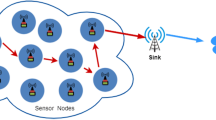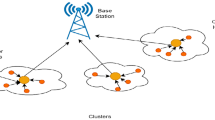Abstract
Sensing and subsequent analysis of the environmental data of a given geographical area is an essential requisite for the planned development of that region. Nowadays, IoT Sensor-Cloud ecosystem has been adopted to collect data from IoT sensors and transmit it to the chosen Cloud Server for further processing and dissemination. In a large Wireless Sensor Network formed by the IoT sensors, there will be a significant amount of redundancy in the dataset when the nodes are placed closely, and the sensed data varies slowly and gradually with regard to time and space. Then, avoiding redundant data transmission can lead to lower energy consumption and communication overhead. Adaptive subset selection of sensor nodes for data size reduction in a Wireless Sensor Network is an approach to efficiently managing the amount of data transmitted within the network. Then, in the current time schedule, it is possible to optimally select a subset of the sensor nodes for data collection without very much affecting the overall data fidelity. An optimal sensor node subset selection scheme that reduces the communication load with minimum information loss is proposed to achieve this task. The unselected nodes are put in sleep mode, which consequently results in lower sensor energy expenditure. The subset selection algorithm is implemented based on the derivative-free pattern search optimizer that minimizes the reconstruction error during the associated extrapolation. This approach differs entirely from the Compressive Data Gathering approach. The simulation results reveal that the performance of the proposed scheme is superior to other similar competitive methods in terms of the mean square error, which is found to be 1.95, with the percentage participation nodes equal to 50% and when the sensor data is uniformly distributed over 20 and 30 units.








Similar content being viewed by others
Data Availability
Not Applicable.
References
Nagaraj, A. (2021). Introduction to sensors in Iot and cloud computing applications. Bentham Science Publishers. https://doi.org/10.2174/97898114793591210101
Kanwal H. T., Arif F., Rubab S. (2021) IoT sensor systems mapping quality parameters using cloud computing. 2021 International Conference on Frontiers of Information Technology (FIT), Islamabad, Pakistan, pp. 176–181https://doi.org/10.1109/FIT53504.2021.00041
Khan A. R., Rakesh N., Bansal A., Chaudhary D. K. (2015) Comparative study of WSN protocols (LEACH, PEGASIS and TEEN). 2015 Third International Conference on Image Information Processing (ICIIP), Waknaghat, India, pp. 422–427, https://doi.org/10.1109/ICIIP.2015.7414810
Kaur G., Bhattacharya M., Chanak P. (2019) Energy conservation schemes of wireless sensor networks for IoT applications: A survey. 2019 IEEE Conference on Information and Communication Technology, pp. 1–6, https://doi.org/10.1109/CICT48419.2019.9066228
Das, K., Das, S., Darji, R., & Mishra, A. (2018). Survey of energy-efficient techniques for the cloud-integrated sensor network. Journal of Sensors, 2018, 1–17. https://doi.org/10.1155/2018/1597089
Wang, X., & Chen, H. (2022). A survey of compressive data gathering in WSNs for IoTs. Wireless Communications and Mobile Computing. https://doi.org/10.1155/2022/4490790
Aziz, A., Singh, K., Osamy, W., & Khedr, A. M. (2020). An efficient compressive sensing routing scheme for internet of things based wireless sensor networks. Wireless Personal Communications, 114(3), 1905–1925. https://doi.org/10.1007/s11277-020-07454-4
He, J., Sun, G., Li, Z., & Zhang, Y. (2016). Compressive data gathering with low-rank constraints for Wireless sensor networks. Signal Processing., 131, 73–76. https://doi.org/10.1016/j.sigpro.2016.08.002
Xu, Y., Sun, G., Geng, T., & Zheng, B. (2019). Compressive sparse data gathering with low-rank and total variation in wireless sensor networks. IEEE Access, 7, 155242–155250. https://doi.org/10.1109/ACCESS.2019.2949050
Tirani, S. P., Avokh, A., & Abouei, J. (2022). Dynamic compressive data gathering using angle-based random walk in hybrid WSNs. Ad Hoc Networks. https://doi.org/10.1016/j.adhoc.2021.102770
Xinmiao, Lu., Yanwen, Su., Qiong, Wu., Wei, Y., & Wang, J. (2022). An improved algorithm of segmented orthogonal matching pursuit based on wireless sensor networks. International Journal of Distributed Sensor Networks, 18(3), 1–10.
Goyal P., Singh B. (2019) Sparse signal recovery through regularized orthogonal matching pursuit for WSNs Applications 2019 6th International Conference on Signal Processing and Integrated Networks (SPIN), Noida, India, pp. 461–465, https://doi.org/10.1109/SPIN.2019.8711716
Krishna, A.N., Srikantaiah, K.C., Naveena, C (2019). [Studies in Computational Intelligence] Integrated Intelligent Computing, Communication and Security Volume 771 || An Efficient Optimization Technique for Scheduling in Wireless Sensor Networks: A Survey. , https://doi.org/10.1007/978-981-10-8797-4(Chapter 24), 223–232. doi:https://doi.org/10.1007/978-981-10-8797-4_24
Idrees, A. K., & Al-Yaseen, W. L. (2021). Distributed genetic algorithm for lifetime coverage optimisation in wireless sensor networks. International Journal Advanced Intelligence Paradigms, 18(1), 3–24.
Wu, L., & Qu, J. (2023). AIMD rule-based duty cycle scheduling in wireless sensor networks using quartile-directed adaptive genetic algorithm. IEEE Sensors Journal, 23(5), 4905–4921. https://doi.org/10.1109/JSEN.2023.3234539
ZainEldin, H., Badawy, M., Elhosseini, M., et al. (2020). An improved dynamic deployment technique based-on genetic algorithm (IDDT-GA) for maximizing coverage in wireless sensor networks. Journal of Ambient Intelligence Humanized Computing, 11, 4177–4194. https://doi.org/10.1007/s12652-020-01698-5
Salim, A., Osamy, W., Khedr, A. M., Aziz, A., & Abdel-Mageed, M. (2021). A secure data gathering scheme based on properties of primes and compressive sensing for IoT-based WSNs. IEEE Sensors Journal, 21(4), 5553–5571. https://doi.org/10.1109/JSEN.2020.3032585
Mazaideh, M. A., & Levendovszky, J. (2021). A multi-hop routing algorithm for WSNs based on compressive sensing and multiple objective genetic algorithm. Journal of Communications and Network, 23(2), 138–147.
Bagwari, A., Logeshwaran, J., Usha, K., Raju, K., Alsharif, M., Uthansakul, P., & Uthansakul, M. (2023). An enhanced energy optimization model for industrial wireless sensor networks using machine learning. IEEE Access. https://doi.org/10.1109/ACCESS.2023.3311854
Wang, X., Chen, H., & Li, S. (2023). A reinforcement learning-based sleep scheduling algorithm for compressive data gathering in wireless sensor networks. Journal on Wireless Communications and Networking, 2023, 28. https://doi.org/10.1186/s13638-023-02237-4
Zhang M., Zhang H., Yuan D., Zhang M. (2019) Compressive sensing and autoencoder based compressed data aggregation for green IoT Networks. 2019 IEEE Global Communications Conference (GLOBECOM), Waikoloa, HI, USA, , pp. 1–6, https://doi.org/10.1109/GLOBECOM38437.2019.9013373
Sekine M., Ikada S. (2021). Adaptive cooperative distributed compressed sensing for edge devices: a multiagent deep reinforcement learning approach In: 19th IEEE Internationa e cooperative distributed compressed sensing for edge devices: a multiagent deep reinforcement learning approach,” In: 19th IEEE International Conference on Pervasive Computing and Communications (IEEE PerCom), Kassel, Germany
“Find minimum of function using genetic algorithm,” https://in.mathworks.com/help/gads/ga.html (accessed on 11–10–2023)
“Interpolate 2-D or 3-D scattered data,” https://in.mathworks.com/help/matlab/ref/griddata.html#bvkwypt-1. (accessed on 11–10–2023)
“Find indices and values of nonzero elements” https://in.mathworks.com/help/matlab/ref/find.html (accessed on 11–10–2023)
“How the genetic algorithm works,” https://in.mathworks.com/help/gads/how-the-genetic-algorithm-works.html (accessed on 11–10–2023)
Funding
The study received no funding.
Author information
Authors and Affiliations
Contributions
S.N. Conceptualized, performed experiments and wrote the article. S.K. participated in conceptualization, supervising the experiments and writing and editing the manuscript. All authors reviewed the manuscript
Corresponding author
Ethics declarations
Conflict of interest
The authors declare that they do not have any competing interests.
Ethical Approval
Not Applicable.
Additional information
Publisher's Note
Springer Nature remains neutral with regard to jurisdictional claims in published maps and institutional affiliations.
Appendix
Appendix
The flow chart of DSS-DSR is shown below. The explanation of various operations is covered in the main document (Fig.
9).
Rights and permissions
Springer Nature or its licensor (e.g. a society or other partner) holds exclusive rights to this article under a publishing agreement with the author(s) or other rightsholder(s); author self-archiving of the accepted manuscript version of this article is solely governed by the terms of such publishing agreement and applicable law.
About this article
Cite this article
Shylashree, N., Kumar, S. Dynamic Sensor Scheduling for Data Size Reduction in a Sensor Cloud System Based on Minimum Reconstruction Error. Wireless Pers Commun 135, 1423–1447 (2024). https://doi.org/10.1007/s11277-024-11090-7
Accepted:
Published:
Issue Date:
DOI: https://doi.org/10.1007/s11277-024-11090-7





